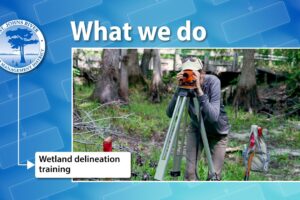We’re improving Lake Apopka North Shore in every way
Nov. 12, 2020
Lake Apopka North Shore is easily one of our most popular St. Johns River Water Management District properties, drawing more than 122,000 visitors last year for hiking, bicycling and world-class birding. And those numbers continue to climb as trails are expanded and features are improved.
These recreational opportunities are available because of the District’s continuing work at the former muck farms where wetlands are being restored to help improve Lake Apopka’s water quality. These recovering wetlands are now attracting wildlife and especially migratory birds. As of March 2017, a total of 369 unique bird species were recorded here, more than any other inland site in the U.S.
While making great progress, our work was interrupted in 2017 when Hurricane Irma wreaked havoc on the North Shore, flooding nearly 75 percent of the 20,000-acre property as the lake overtopped the levee. Our dedicated staff responded quickly, making temporary repairs, and then reinforcing the entire levee to reduce the chances of future flooding.
I’m pleased to report that we’re continuing to work on or have completed a host of improvements to the Lake Apopka North Shore. Some of the upgrades are apparent, such as repairing and capping the Lake Apopka Loop Trail and Lake Apopka Wildlife Drive. The 11-mile drive meanders through the eastern portion of the property.
Many of our additional projects are integral to the North Shore’s purpose of improving Lake Apopka’s water quality. Among the highlights:
- The installation of a pump station that will provide additional water and phosphorus management capacity to the North Shore, reducing phosphorus loading to Lake Apopka, is nearly complete. Reducing phosphorus in the lake is the key to reducing algal abundance and clearing the water enough for submerged aquatic vegetation to recover.
- We’ve overhauled pumps and are rehabilitating treatment cells at the Marsh Flow-Way, which filters Lake Apopka’s water, removing phosphorus, algae and suspended sediments.
- In October, we began another phase of submerged aquatic habitat planting to help accelerate the recovery of the vegetation in Lake Apopka, which is critical habitat and another step toward recovering what was once a world-class fishery.
- Operations of an innovative pay-for-performance project designed to remove phosphorus from Lake Apopka and return the treated water back to the lake are underway.
Additional work within the North Shore property will include raising internal levees and roads that will help improve operational flexibility for long-term water management and resiliency. Restoring water quality to recover a world-class fishery in one of Florida’s largest lakes and returning former wetlands that attract a wide diversity of wildlife takes a dedication to science and innovation. Judging from the improvements to water quality we are documenting and the many emails, calls and images we receive from happy visitors to the Lake Apopka North Shore, the efforts are paying off.






